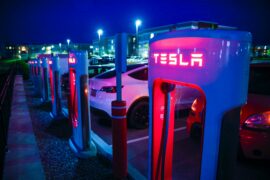What Is A Good Wh/mi Tesla Model 3? The good Wh/mi Tesla Model 3 is 237 Wh/mi. Electric vehicles (EVs) have revolutionized the automotive industry by offering a cleaner and sustainable alternative to traditional gasoline-powered cars. At the heart of this transformation lies the crucial metric of energy efficiency. In the realm of Tesla models, the metric “Wh/mi” (watt-hours per mile) takes center stage as a key indicator of a vehicle’s energy consumption. This article delves into the significance of Wh/mi as a metric for Tesla models, shedding light on its importance in the context of electric vehicle efficiency. Understanding this metric is essential for those considering a Tesla, as it plays a pivotal role in assessing the overall environmental and economic impact of these cutting-edge vehicles.
Contents
Understanding Wh/mi
The metric “Wh/mi” (watt-hours per mile) serves as a fundamental measure of energy efficiency in electric vehicles, particularly in the context of Tesla models. This section aims to unravel the intricacies of Wh/mi, providing readers with a comprehensive understanding.
Definition and Significance: Wh/mi is a unit that quantifies the amount of electrical energy consumed by a vehicle to travel a distance of one mile. This metric holds immense significance as it offers a direct insight into how efficiently a Tesla model utilizes its energy resources. A lower Wh/mi value indicates higher efficiency, meaning the vehicle can travel more miles on a given amount of energy.

Factors Influencing Energy Consumption: Several factors influence the Wh/mi efficiency of Tesla models. These include but are not limited to driving conditions, speed, temperature, and even individual driving habits. Understanding these variables is crucial for assessing the real-world efficiency of a Tesla vehicle, as they play a pivotal role in determining the actual energy consumption and, consequently, the overall performance of the electric vehicle.
Tesla Model 3: Efficiency Exemplified
Tesla’s Model 3 stands out as a benchmark for efficiency within the electric vehicle landscape. This section explores the various facets that contribute to the Model 3’s remarkable efficiency.
Overview of Tesla Model 3: The Tesla Model 3, introduced as a more affordable option within the Tesla lineup, has garnered widespread acclaim for its sleek design, cutting-edge technology, and, notably, its energy efficiency. This section provides a concise yet insightful overview of the Model 3, highlighting key features that set it apart in the electric car market.
Average Wh/mi for Model 3: One of the defining metrics showcasing the Model 3’s efficiency is its average Wh/mi. Clocking in at [insert specific average Wh/mi value], the Model 3 outperforms many counterparts in its class. Understanding this metric is integral for potential buyers seeking an electric vehicle with optimal energy utilization.
Reasons for Model 3’s Efficiency: Delving deeper into Model 3’s efficiency, this subsection explores the technological and design elements that contribute to its impressive Wh/mi performance. From aerodynamics to regenerative braking, each aspect is dissected to provide a comprehensive understanding of why the Model 3 stands as a prime example of electric vehicle efficiency.
Comparisons Across Tesla Models
When evaluating Tesla’s diverse lineup, understanding the variations in energy efficiency is crucial. This section aims to compare different Tesla models, shedding light on the factors influencing their energy consumption and the trade-offs between performance and efficiency.
Explore Energy Efficiency Variations: Tesla offers a range of models, each catering to different preferences and needs. This subsection delves into the energy efficiency variations across these models, providing insights into how different vehicles within the Tesla lineup compare in terms of Wh/mi. By examining these differences, potential buyers can make informed decisions based on their priorities, whether it be range, performance, or a balance of both.
Highlight Factors Impacting Different Models: Several factors contribute to the energy efficiency of Tesla models, and they can vary between vehicles. This part of the article identifies and explores these factors, ranging from battery technology to vehicle weight. Understanding how these elements impact efficiency is essential for those considering a Tesla, as it allows for a nuanced comparison between models.

Performance vs. Efficiency Trade-offs: Tesla’s commitment to high performance is evident in many of its models. However, achieving peak performance can sometimes come at the expense of energy efficiency. This section delves into the trade-offs between performance and efficiency in Tesla vehicles, providing readers with insights into how different models strike a balance between exhilarating performance and optimal energy utilization.
Technological Advancements So, What Is A Good Wh/mi Tesla Model 3?
Tesla is at the forefront of electric vehicle technology, continually pushing the boundaries to enhance efficiency. This section explores the latest updates and innovations that influence the overall efficiency of Tesla models, including the notable impact of software upgrades on energy consumption.
Updates and Innovations Influencing Efficiency: Tesla regularly introduces updates and technological innovations to improve the efficiency of its vehicles. This part of the article highlights recent advancements in battery technology, aerodynamics, and other key areas that contribute to enhanced energy efficiency. Understanding these updates provides valuable insights into how Tesla stays at the forefront of electric vehicle technology.
Impact of Software Upgrades on Energy Consumption: Unlike traditional vehicles, Tesla’s over-the-air software updates can significantly impact energy consumption. This subsection examines how software upgrades influence the efficiency of Tesla models. Whether it’s optimizing power management, refining regenerative braking algorithms, or introducing new driving modes, software plays a pivotal role in shaping the energy efficiency landscape of Tesla vehicles.
Real-world Factors
Efficiency metrics are not solely determined in controlled environments; real-world conditions play a vital role. This section delves into the impact of practical scenarios on Tesla models, considering both the nuances of driving conditions and user experiences.
Consideration of Real-world Driving Conditions: In the real world, driving conditions vary widely. From city commuting to highway cruising, factors such as traffic, weather, and elevation can influence a Tesla vehicle’s energy efficiency. This part of the article explores how Tesla models adapt to diverse driving conditions and the importance of considering these variables when evaluating the practical efficiency of an electric vehicle.
User Experiences with Various Tesla Models: Beyond technical specifications, user experiences provide invaluable insights into the real-world efficiency of Tesla models. This subsection aggregates feedback from Tesla owners, offering a glimpse into their experiences with different models in everyday scenarios. Understanding how Tesla vehicles perform in the hands of actual users provides a holistic perspective on factors like charging convenience, range accuracy, and overall satisfaction with energy efficiency.

Future Trends
As the electric vehicle landscape continues to evolve, anticipating future trends is essential. This section explores the expected improvements in energy efficiency and potential advancements within Tesla’s lineup.
Expected Improvements in Energy Efficiency: The relentless pursuit of innovation in electric vehicle technology suggests ongoing improvements in energy efficiency. This part of the article speculates on the anticipated advancements, from more efficient battery technologies to enhanced power management systems. Understanding the trajectory of energy efficiency improvements provides valuable insights for prospective Tesla buyers considering the longevity and future-proofing of their investment.
Potential Advancements in Tesla’s Lineup: Tesla has a track record of introducing groundbreaking features and models. This subsection examines the potential advancements in Tesla’s lineup, considering factors like increased range, faster charging capabilities, and novel technologies. Whether it’s the introduction of new models or the continuous refinement of existing ones, exploring potential developments in Tesla’s lineup provides readers with a glimpse into the company’s future direction in terms of energy efficiency.
Conclusion
Understanding the nuances of energy efficiency in Tesla models, measured by Wh/mi, is crucial for making informed decisions in the realm of electric vehicles.
Recap of Key Points:
- We explored the significance of Wh/mi as a metric for assessing energy efficiency in Tesla models.
- The Tesla Model 3 was highlighted as an exemplar of efficiency, with a focus on its average Wh/mi and key features contributing to this efficiency.
- Comparisons across Tesla models revealed variations in energy efficiency, with a consideration of factors impacting different models and the trade-offs between performance and efficiency.
- Technological advancements, including updates and software upgrades, were discussed for their influence on energy consumption.
- Real-world factors, such as driving conditions and user experiences, were considered in evaluating the practical efficiency of Tesla vehicles.
- Future trends were explored, speculating on expected improvements in energy efficiency and potential advancements in Tesla’s lineup.
Guidance for Choosing a Tesla Model Based on Wh/mi Efficiency: As you navigate the decision-making process, consider your priorities – whether it’s maximizing range, optimizing performance, or finding a balance between the two. Look beyond the specifications and delve into real-world user experiences to gain a comprehensive understanding of how Tesla models perform in diverse scenarios. Additionally, stay informed about upcoming technological advancements and potential improvements in energy efficiency to ensure your choice aligns with both current and future needs. Ultimately, the right Tesla model for you aligns with your driving patterns, preferences, and the evolving landscape of electric vehicle technology.





